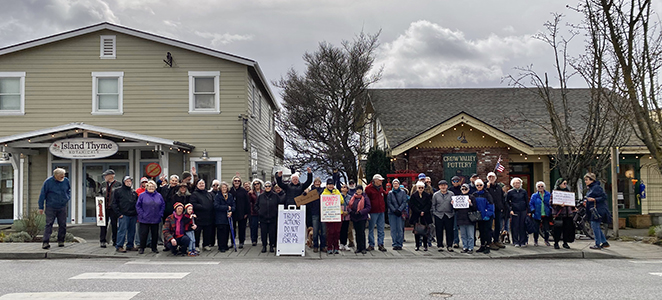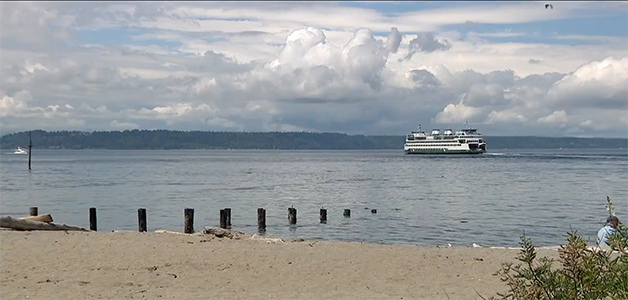“There ought to be a law” or more specifically, “What buffer width approach will best serve San Juan County?”
And so began the long, drawn-out process that resulted in laws to protect the San Juan County environment. In the interest of protecting the county’s natural lands and shorelines, county staff and citizens have been working to revise the Critical Areas Ordinance (CAO). For two years the citizens’ committee met and has now produced a draft ordinance that committee members say will affect every property — and property owner — in the County for years to come.
Last Thursday, Nov. 12, a field trip that drew out about 30 people, and an afternoon workshop that nearly filled the Lundeen Room of the Senior Center, brought attention to the draft ordinance, which will come before the County Planning Commission and the County Council this winter.
The Critical Areas Ordinance is a part of the Growth Management Act that is periodically required to be updated. The draft ordinance update concerns t the uplands portion of the county’s critical areas.
The shorelines portion of the CAO will be addressed by county staff who will create a draft which “feeds into” the Shoreline Master Program — plans required by the Shoreline Management Act, including streams and lakes of a certain size.
Funding is currently in place to define the scope of work for the shorelines process by the end of 2009, and that portion of the ordinance update is to be completed by the end of 2012.
Jim Kramer, a Seattle-based engineer who helped write King County’s stormwater management plan, has been asked by the County to facilitate three workshops on San Juan, Lopez and Orcas Island to bring out community concerns regarding the two-year update to the Critical Areas Ordinance.
Last week, during the afternoon workshop, Kramer and a panel of environmental experts met with the Orcas Island community to review the ordinance and to hear islanders’ opinions about that work.
Questions at the two-hour meeting ranged from whether orchards can be considered detrimental or mitigating, to whether there is a need for changes to the ordinance at all. That last point brought out that San Juan County does not yet have a “Critical Areas” ordinance per se, but rather an “Environmentally Sensitive Areas” ordinance that needs to be considered in adopting a critical areas ordinance.
At the workshop, Kramer introduced the panel of experts:
- Dr. Ken Brooks — high-energy particle physicist, marine biologist, representative on UN committees for sustainability and offshore and wetlands management. A “devoted conservationist,” Brooks stated his belief that “the best stewards are property owners.”
- Paul Anderson, — State Department of Ecology (DOE) wetland specialist responsible for San Juan County; involved with permit review and approval and technical assistance, including commentary on CAOs.
- Eric Stockdale — wetlands specialist with State DOE, supervising wetlands and permitting for the Northwest region. Stockdale’s previous work includes research on the urbanization of wetlands in King County, using methods identified as “Best Available Science.”
- Amanda Azous — environmental engineer and certified wetland scientist and a resident of the San Juans since 1991; co-author of a 10-year study looking at the effects of urbanization on wetlands.
Kramer spoke several times of the importance for individuals to give their perspective on the issues and communicate them to the County. Comments to County Planner, Shireene Hale, in charge of the CAO update process, can be sent to shireeneh@sanjuan.co. com. Comments on the ordinance draft and the workshops should be sent by Nov. 18 so that they can be incorporated in a report to the County Council on the public’s input by Dec. 1.
An oversight committee, composed of Patty Miller, Shireene Hale, Amy Windrope, San Juan Initiative staff, and Susan Dehlendorf from the Planning Commission, will put their report on the CAO update process thus far before the County Council on Dec. 1. The council will then be briefed on the CAO update draft at their Dec. 8 public meeting.
Public Hearings before the Planning Commission and the County Council will then be scheduled later this winter, and comments from the public are welcome throughout the process.
About 30 people attended the field trip portion of the Nov. 12 Orcas Island meeting, featuring the Eastsound wetlands. At the late-afternoon meeting, about 50 people filled the Lundeen Room; and about half in attendance identified themselves as wetlands property owners.
After giving an overview of the lands identified as wetlands and their classes, Kramer solicited opinions as to whether the buffers surrounding the critical areas were sufficient or excessive in protecting the critical area and whether alternative approaches – “proscriptive or totally flexible” should be considered by the Council and the Planning Commission.
Kramer said that the intent is for the regulations to be:
- clear and understandable
- multiple options for compliance
- meets state requirements
- streamlined application for property owners
- can be successfully implemented by county
The uses and restrictions on uses in buffers of critical areas was discussed, and gave rise to the rationale in prohibiting new gardens and orchards in some buffers.
Anderson, speaking on behalf of the (DOE) said that the concerns are with new orchards and gardens in existing forest or scrub or natural grasslands. Janet Alderton, environmental scientist who lives in Deer Harbor, said that orchards increase water runoff rather than permeation.
Stephanie Buffum, Director of the Friends of the San Juans who was on the citizen CAO update committee, said that she had written a minority opinion supportive of the agriculture movement, but “because there are so many agricultural exemptions already in the CAO,” her opposition to new orchards and gardens is “because these ARE critical areas.” Buffum added that she wanted a continued discussion about the matter.
Ken Brooks disagreed with the idea that orchards don’t provide ecological function.
Anderson brought out the need for preserving the greater diversity of forested areas. “Forest wetlands do and can provide high function and both the State and the Army [Corps of] Engineers] value them as high quality wetlands that shouldn’t be converted to other use — even though clearance does provide more diversity — but forest may have functions that are not so visible, and more difficult to replace.”
The formula for allowing expansion of existing structures was brought up, as was the construction of trails in critical areas and buffer zones.
Walt Corbin said that in the past, clearing his land and digging ponds had been encouraged, and resulted in an increase in wildlife. He questioned why that was now prohibited. Anderson allowed that such activities may be restorative, but said, “If a person is digging a pond in a wetland area, [he] needs State and probably federal permission.”
Participants in the meeting brought out that the Eastsound swale is impacted by invasive species, such as hawthorn trees which were grafted to native orchard species to make a hardier root stock. The hybrid hawthorn has “taken over the swale area. It would benefit the swale to remove that species and allow native species to regenerate in that area.”
Patty Miller, a member of the citizens CAO update committee spoke for the need to balance environmental protection provided by uses and restrictions with the need for flexibility to protect the property owners.
Mitigation in areas where the impact is calculated to be more than 2,500 square feet brought out that it is less costly to minimize impacts on the landscape.
Fred Klein, Eastsound Planning and Review Committee (EPRC) member, said that OPAL’s Wild Rose Meadow affordable housing project was built on “wetlands that had county permits; they were ready to go, but were held up at the State, and spent about $150,000 on consultants alone to re-do their development.
“This was basically an isolated wetland that the Corps of Engineers doesn’t care about. I’m not persuaded that mitigation for buffer areas is really justifiable,” Klein said.
Tim Blanchard said that ordinance provisions regarding wildlife habitiat, “could affect every lot, any property – not just wetlands or buffers.”
County Senior Planner Shireene Hale, in charge of the CAO update process, responded that the number of endangered species is “fairly limited.”
Local excavator Bruce Wiscomb asked if there has ever been “an independent audit to see if the present ordinances are working or not.”
Norm McCloud said, although he’d been told that an audit had not been done because the county couldn’t afford the expense, that the issue involves a “political process that impacts individual citizens… If you’re going to have substantial financial impacts on individual property owners, [an audit] should be independent of funding of state agencies… It should be rigorous and represent a synthesis of scientific studies.”
McCloud said,”The requirement is a review and — if necessary — modification tthat is more OR less restrictive.”
Eric Stockdale responded by saying that DOE publishes multi-agency research that is guided by local, state and federal scientists and planners, as well as a “responsiveness document,” that takes about a year and a half for peer review following publication.
Azous said that, as a wetlands specialist, she had been asked to comment on such reviews, “as was every wetlands scientist.”
Brooks emphasized that the Growth Management Act (GMA) requires you to develop a CAO that is reflective of your critical areas and reflects your values … this should reflect your community and the desire of your citizens.”
John Evans, former County Commissioner urged the county to “come up with a simple way to redesignate native growth area to better reflect wetlands.”
In summarizing some of the discussion, Kramer asked, “What buffer width approach will best serve San Juan County?”
He listed the range of options
- Prescriptive fixed width based on wetland class (probably easiest to administer with limited wetland expertise, fairly straightforward; not as tailored to specific situations)
- Variable width based on functions and land use (a lot more specifics to the site, based on Island County approach)
- Site-specific Critical Area Stewardship Plan CASP (least capable of indicating requirements, most costly in proposal, and review process “wide open.”)
Janet Alderton compared the task before the County Council and citizens to a medical emergency: “We don’t have time and resources for more science and research, but we can’t fail to treat because we don’t have final answers.”
Those who would like to submit comments for consideration regarding the CAO update, are asked to contact Shireene Hale at shireeneh@sanjuanco.com.
**If you are reading theOrcasonian for free, thank your fellow islanders. If you would like to support theOrcasonian CLICK HERE to set your modestly-priced, voluntary subscription. Otherwise, no worries; we’re happy to share with you.**







